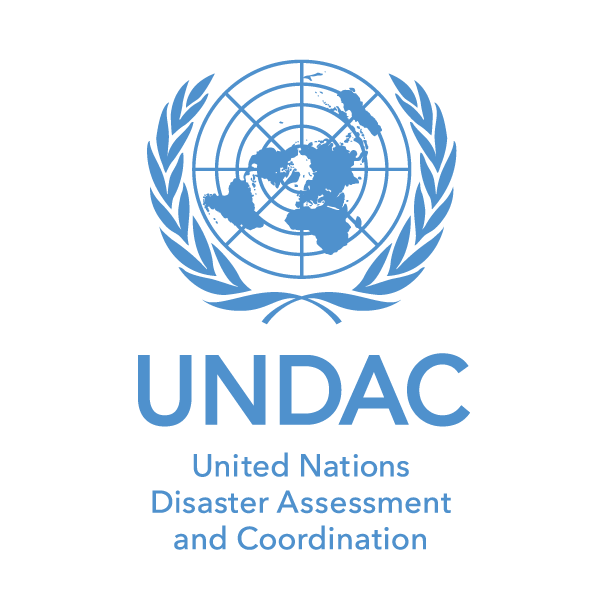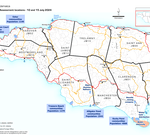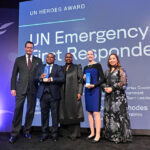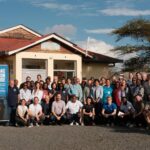UNDAC
© UNOCHA
UNDAC – United Nations Disaster Assessment and Coordination
The United Nations Disaster Assessment and Coordination (UNDAC) system is a part of the Office for the Coordination of Humanitarian Affairs (OCHA). It serves as the international response system for sudden-onset emergencies, such as an earthquake or a flood, and is designed to help the United Nations and governments of disaster affected countries during the first phase of an emergency.
See more in About UNDAC.

Updates
- UN Heroes Award – UNDAC and INSARAGOn 22 November, the 30 years of exceptional work by the INSARAG and UNDAC networks were celebrated during the UN Foundation’s We the Peoples Award… Read more: UN Heroes Award – UNDAC and INSARAG
- Mr. Tom Fletcher as OCHA’s new Under-Secretary-General for Humanitarian Affairs and Emergency Relief CoordinatorMr. Tom Fletcher has started his new role as the new Under-Secretary-General for Humanitarian Affairs and Emergency Relief Coordinator at the United Nations Office for… Read more: Mr. Tom Fletcher as OCHA’s new Under-Secretary-General for Humanitarian Affairs and Emergency Relief Coordinator
- UNDAC Refresher Course in China, 2024The UNDAC Refresher Course was successfully held in China from 23-26 September 2024. This valuable event was hosted by the Ministry of Emergency Management and organized by the National Earthquake Response Support Service at their training center in Beijing. A diverse group of 19 UNDAC members from 11 countries across the Asia-Pacific, Europe, and Africa participated, enriching the experience with their varied perspectives. The course was expertly facilitated with the support of two staff members from OCHA’s Regional Office for Asia and the Pacific (ROAP), enhancing the training’s effectiveness and impact.
- Global UNDAC Induction in Nairobi, Kenya (27th October to 8th November 2024)A global UNDAC induction was held in Nairobi, Kenya from 27th October to 8th November 2024 at the Humanitarian Peace Support School (HPSS) in Embakasi,… Read more: Global UNDAC Induction in Nairobi, Kenya (27th October to 8th November 2024)
- SADC ERT Induction in Maun, Botswana (7-19 July 2024)Southern Africa Development Community (SADC) Emergency Response Team (ERT) is provided for within the SADC Disaster Preparedness and Response Strategy and Fund as a regional… Read more: SADC ERT Induction in Maun, Botswana (7-19 July 2024)
Latest Situation Reports
- Grenada: After the storm: Two months after Hurricane BerylCountries: Grenada, Jamaica, Saint Vincent and the Grenadines Source: UN Office for the Coordination of Humanitarian Affairs “When we arrived in Carriacou, we saw… Read more: Grenada: After the storm: Two months after Hurricane Beryl
- Jamaica: Assessment locations – 10 and 15 July 2024
 Country: Jamaica Source: MapAction Please refer to the attached Map. Map shows the location of the assessments carried out on 10 July 2024. Teams… Read more: Jamaica: Assessment locations – 10 and 15 July 2024
Country: Jamaica Source: MapAction Please refer to the attached Map. Map shows the location of the assessments carried out on 10 July 2024. Teams… Read more: Jamaica: Assessment locations – 10 and 15 July 2024 - Grenada: Eastern Caribbean: Hurricane Beryl – Situation Report No. 06 (As of 14 August 2024)
 Countries: Grenada, Saint Vincent and the Grenadines Source: UN Office for the Coordination of Humanitarian Affairs Please refer to the attached file. Following the… Read more: Grenada: Eastern Caribbean: Hurricane Beryl – Situation Report No. 06 (As of 14 August 2024)
Countries: Grenada, Saint Vincent and the Grenadines Source: UN Office for the Coordination of Humanitarian Affairs Please refer to the attached file. Following the… Read more: Grenada: Eastern Caribbean: Hurricane Beryl – Situation Report No. 06 (As of 14 August 2024) - Grenada: Eastern Caribbean: Hurricane Beryl – Situation Report No. 05 (As of 29 July 2024)
 Countries: Grenada, Saint Vincent and the Grenadines Source: UN Office for the Coordination of Humanitarian Affairs Please refer to the attached file. This report… Read more: Grenada: Eastern Caribbean: Hurricane Beryl – Situation Report No. 05 (As of 29 July 2024)
Countries: Grenada, Saint Vincent and the Grenadines Source: UN Office for the Coordination of Humanitarian Affairs Please refer to the attached file. This report… Read more: Grenada: Eastern Caribbean: Hurricane Beryl – Situation Report No. 05 (As of 29 July 2024) - Grenada: Eastern Caribbean: Hurricane Beryl – Situation Report No. 04 (As of 19 July 2024)
 Countries: Grenada, Saint Vincent and the Grenadines Source: UN Office for the Coordination of Humanitarian Affairs Please refer to the attached file. This report… Read more: Grenada: Eastern Caribbean: Hurricane Beryl – Situation Report No. 04 (As of 19 July 2024)
Countries: Grenada, Saint Vincent and the Grenadines Source: UN Office for the Coordination of Humanitarian Affairs Please refer to the attached file. This report… Read more: Grenada: Eastern Caribbean: Hurricane Beryl – Situation Report No. 04 (As of 19 July 2024)






